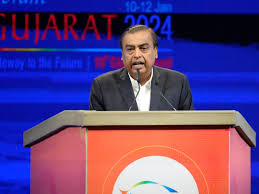
India’s Surging Russian Oil Imports: Powered by Asia’s Richest Man

 :
| Updated On: 22-Aug-2025 @ 11:49 am
:
| Updated On: 22-Aug-2025 @ 11:49 amSHARE
Former US President Donald Trump has imposed an additional 25 percent tariff on India’s imports of Russian oil, accusing New Delhi of indirectly financing Moscow’s war in Ukraine. This move has placed India among the highest tariffed nations so far. While India and Russia have shared a longstanding strategic partnership dating back to the Cold War, with Russia supplying a significant portion of India’s defense equipment, Trump’s criticism is largely directed at the recent spike in India’s oil imports from Russia. On July 30, Trump posted on Truth Social that India and China were Russia’s largest energy buyers at a time when the world was urging Moscow to halt its invasion of Ukraine.
On August 19, US Treasury Secretary Scott Bessent stated that some of India’s wealthiest families were the biggest beneficiaries of this trade. Chief among them is Reliance Industries Limited (RIL), headed by Asia’s richest man, Mukesh Ambani. RIL has become the largest Indian importer of Russian crude oil, which rose from just 3 percent of total crude processed at its Jamnagar refinery in 2021 to 50 percent in 2025. According to the Centre for Research on Energy and Clean Air (CREA), in the first seven months of 2025 alone, the Jamnagar refinery imported 18.3 million tonnes of Russian crude—worth $8.7 billion—a 64 percent year-on-year increase.
The surge is linked to the Russian oil price cap introduced in February 2023, aimed at reducing Russian revenues while ensuring global supply security. However, its effectiveness has waned due to the cap’s stagnation at $60 per barrel and weak enforcement. Moreover, Russia’s “shadow fleet”—hundreds of vessels evading sanctions—has enabled buyers to pay above the cap. As of January 2025, 83 percent of Russian crude was shipped via this fleet, though the share dropped to 59 percent in June.
CREA’s data shows that between February 2023 and July 2025, Jamnagar exported $85.9 billion in refined petroleum products worldwide, with $36 billion going to countries sanctioning Russia. About a third of total exports—€17 billion ($19.7 billion)—went to the EU, while the US imported $6.3 billion worth of oil products, $2.3 billion of which were refined from Russian crude. The US ranks fourth in value but first in volume of imports from Jamnagar since the price cap, receiving 8.4 million tonnes of products. In 2025 alone, US imports reached $1.4 billion, a 14 percent increase year-on-year. Most US imports from Jamnagar are blending components, petrol, and fuel oils.
Nayara Energy, majority-owned by Russian companies including state giant Rosneft, is India’s second-biggest importer of Russian crude. Its Vadinar refinery sources 66 percent of its crude from Russia, though the total volume amounts to only a third of RIL’s Russian imports.
Analysts argue that it is simplistic to view the tariffs as targeting Reliance alone. India continues this trade partly because cheaper Russian oil helps ease its current account deficit and reflects its traditional policy of non-alignment. Ajay Srivastava of the Global Trade Research Initiative called Trump’s tariffs “a total sham,” noting that China—the biggest importer of Russian oil—has not faced similar penalties, possibly because Trump is reluctant to confront Beijing directly. He suggested the tariffs are more about US-India trade tensions than Ukraine.
Looking ahead, the EU is set to enforce a ban in January on refined petroleum derived from Russian crude, which could significantly affect RIL, especially since more than half its jet fuel exports go to Europe. This may force the company to reconsider its export strategy, despite having signed a 10-year contract with Rosneft in December.